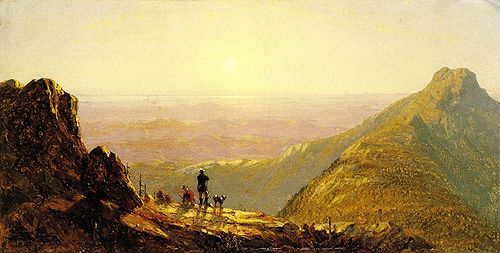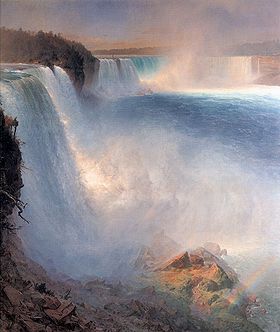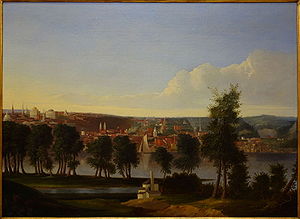The Hudson River School
 From Conservapedia
From Conservapedia The Hudson River School was not an institution but rather an informal group of like-minded painters. Its name was coined to identify a group of New York City-based landscape painters. [1] Thomas Cole (1801-1848) is acknowledged as the founder of this movement. The movement was fueled by the poetry of Ralph Waldo Emerson (1803-1882) and by the conviction that God had given the American people an abundance of natural resources as a source of wealth and prosperity. Cole's close friend, Asher Durand was also a prominent figure in the School. Durand believed that nature was an ineffable manifestation of God. Thomas Doughty, member of the School, was the first American artist to work exclusively as a landscapist. Other painters of the movement are Cole's prize pupil Frederic Edwin Church, Thomas Moran, Albert Bierstadt, John Frederick Kensett, William Hart and Sanford Robinson Gifford.
The Hudson River painters created visual embodiments of the ideals about which Emerson, Thoreau, William Cullen Bryant, and Walt Whitman wrote... the Hudson River painters believed art to be an agent of moral and spiritual transformation. [2]
The Hudson River School style involved carefully detailed paintings with romantic, almost glowing lighting. With realistic composition, they depicted romantic views of unsettled areas of the Hudson River Valley especially lakes, rocky gorges, and forests in the Catskill Mountains, the surrounding areas, the Niagara, and the American West. [3]

Thomas Cole, The Clove Catskills, 1827.

Tomas Cole, Landscape Scene from the Last of the Mohicans.

Thomas Doughty, In the Catskills, 1836.

Asher Durand, Kindred Spirits, 1849.

Sanford Robinson Gifford, Coming Storm, ca. 1860.

Asher Durand, Pastoral Landscape, 1861.

Albert Bierstadt, Looking Down Yosemite-Valley, 1865.

John Frederick Kensett, Mount Washington, 1869.

Thomas Moran, Shoshone Falls, Idaho, 1875.

Sanford Robinson Gifford, Mount Mansfield, 1858.
See also[edit]
- Painting Schools
- Painting Galleries
- American Painting
External links[edit]

- The Hudson River School.
- American Landscape Painting.
- The Hudson River School. The Metropolitan Museum of Art.
- Hudson River School-Painters of Faith.

Categories: [Painting]
↧ Download as ZWI file | Last modified: 02/24/2023 17:35:01 | 17 views
☰ Source: https://www.conservapedia.com/The_Hudson_River_School | License: CC BY-SA 3.0
 ZWI signed:
ZWI signed: KSF
KSF